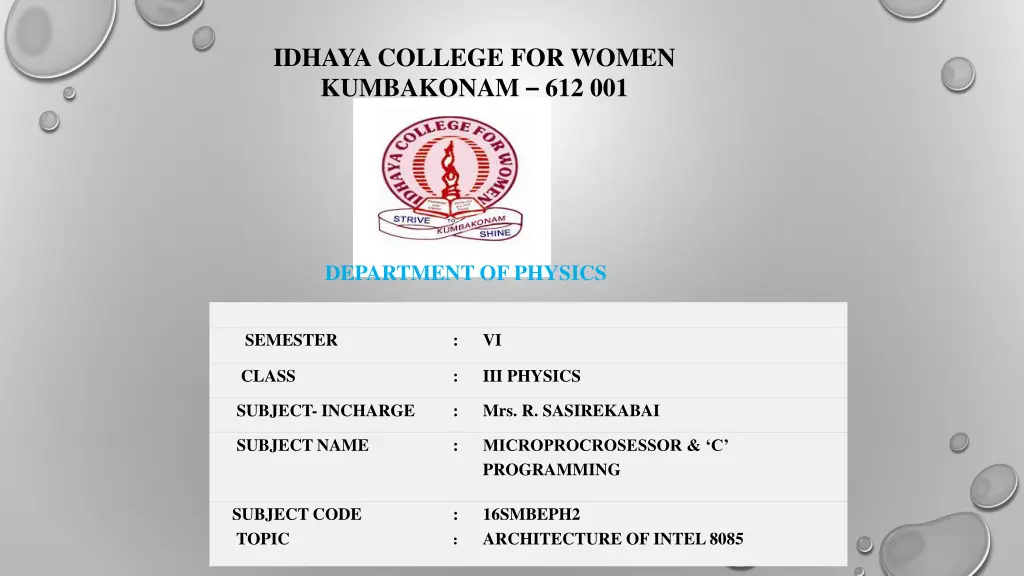
Exploring the Architecture of Intel 8085 Microprocessor
Discover the significance and components of the Intel 8085 microprocessor, a key player in the realm of 8-bit general-purpose microprocessors. From its introduction in 1976 to its functional units and architecture, delve into the world of this powerful technology. Uncover how the Intel 8085 processes data and addresses memory, showcasing its importance in various applications such as washing machines, microwave ovens, and more.
Download Presentation

Please find below an Image/Link to download the presentation.
The content on the website is provided AS IS for your information and personal use only. It may not be sold, licensed, or shared on other websites without obtaining consent from the author. If you encounter any issues during the download, it is possible that the publisher has removed the file from their server.
You are allowed to download the files provided on this website for personal or commercial use, subject to the condition that they are used lawfully. All files are the property of their respective owners.
The content on the website is provided AS IS for your information and personal use only. It may not be sold, licensed, or shared on other websites without obtaining consent from the author.
E N D
Presentation Transcript
IDHAYA COLLEGE FOR WOMEN KUMBAKONAM 612 001 DEPARTMENT OF PHYSICS SEMESTER : VI CLASS : III PHYSICS SUBJECT- INCHARGE : Mrs. R. SASIREKABAI SUBJECT NAME : MICROPROCROSESSOR & C PROGRAMMING SUBJECT CODE TOPIC : : 16SMBEPH2 ARCHITECTURE OF INTEL 8085
INTRODUCTION OF INTEL 8085 The Intel 8085 ("eighty-eighty-five") is an 8-bit microprocessor produced by Intel and introduced in March 1976. It is a software-binary compatible with the more-famous Intel 8080 with only two minor instructions added to support its added interrupt and serial input/output features. Manufacturers: Intel Used in computers: IBM System/23
IMPORTANCE OF INTEL 8085 The 8085 microprocessor is an 8-bit general purpose microprocessor which is capable to address 64k of memory. This processor has forty pins, requires +5 V single power supply and a 3-MHz single-phase clock. The ALU perform the computing function of microprocessor. Accumulator is an 8-bit register that is part of ALU. This register is used to store 8-bit data & in performing arithmetic & logic operation. Flags are programmable. They can be used to store and transfer the data from the registers by using instruction. And registers are used to storage purposes normally program counter ,stack are used as storage registers.
INTEL 8085 COMPONENTS 8085 is pronounced as "eighty-eighty-five" microprocessor. It is an 8-bit microprocessor designed by Intel in 1977 using NMOS technology. It has the following configuration 8-bit data bus 16-bit address bus, which can address upto 64KB A 16-bit program counter A 16-bit stack pointer Six 8-bit registers arranged in pairs: BC, DE, HL Requires +5V supply to operate at 3.2 MHZ single phase clock It is used in washing machines, microwave ovens, mobile phones, etc.
8085 Microprocessor Functional Units 8085 consists of the following functional units Accumulator It is an 8-bit register used to perform arithmetic, logical, I/O & LOAD/STORE operations. It is connected to internal data bus & ALU. Arithmetic and logic unit As the name suggests, it performs arithmetic and logical operations like Addition, Subtraction, AND, OR, etc. on 8-bit data. General purpose register There are 6 general purpose registers in 8085 processor, i.e. B, C, D, E, H & L. Each register can hold 8-bit data. These registers can work in pair to hold 16-bit data and their pairing combination is like B-C, D-E & H-L. Program counter It is a 16-bit register used to store the memory address location of the next instruction to be executed. Microprocessor increments the program whenever an instruction is being executed, so that the program counter points to the memory address of the next instruction that is going to be executed. Stack pointer It is also a 16-bit register works like stack, which is always incremented/decremented by 2 during push & pop operations.
Temporary register It is an 8-bit register, which holds the temporary data of arithmetic and logical operations . Flag register It is an 8-bit register having five 1-bit flip-flops, which holds either 0 or 1 depending upon the result stored in the accumulator. These are the set of 5 flip-flops Sign (S) Zero (Z) Auxiliary Carry (AC) Parity (P) Carry (C) Its bit position is shown in the following table D7 D6 D5 D4 D3 D2 D1 D0 S Z AC P CY
Instruction register and decoder It is an 8-bit register. When an instruction is fetched from memory then it is stored in the Instruction register. Instruction decoder decodes the information present in the Instruction register. Timing and control unit : It provides timing and control signal to the microprocessor to perform operations. Following are the timing and control signals, which control external and internal circuits Control Signals: READY, RD , WR , ALE Status Signals: S0, S1, IO/M DMA Signals: HOLD, HLDA RESET Signals: RESET IN, RESET OUT Interrupt control : As the name suggests it controls the interrupts during a process. When a microprocessor is executing a main program and whenever an interrupt occurs, the microprocessor shifts the control from the main program to process the incoming request. After the request is completed, the control goes back to the main program. There are 5 interrupt signals in 8085 microprocessor: INTR, RST 7.5, RST 6.5, RST 5.5, TRAP. Serial Input/output control : It controls the serial data communication by using these two instructions: SID (Serial input data) and SOD (Serial output data). Address buffer and address-data buffer : The content stored in the stack pointer and program counter is loaded into the address buffer and address-data buffer to communicate with the CPU. The memory and I/O chips are connected to these buses; the CPU can exchange the desired data with the memory and I/O chips.
8085 Pin description Higher Order Address pins- A15 A8 The address bus has 8 signal lines A8 A15 which are unidirectional. Lower Order Address/ Data Pins- AD7-AD0 These are time multiplexed pins and are de-multiplexed using the pin ALE So, the bits AD0 AD7 are bi-directional and serve as A0 A7 and D0 D7 at the same time. During the execution of the instruction, these lines carry the address bits during the early part, then during the late parts of the execution, they carry the 8 data bits. In order to separate the address from the data, we can use a latch to save the value before the function of the bits changes. Control Pins RD, WR These are active low Read & Write pins Status Pins ALE, IO/M (active low), S1, S0 ALE (Address Latch Enable)-Used to de-multiplex AD7-AD0 IO/M Used to select I/O or Memory operation S1,S0 Denote the status of data on data bus
Interrupt Pins TRAP, RST7.5, RST 6.5, RST 5.5, INTR, INTA These are hardware interrupts used to initiate an interrupt service routine stored at predefined locations of the system memory. Serial I/O pins SID (Serial Input Data), SOD (Serial Output Data) These pins are used to interface 8085 with a serial device. Clock Pins- X1, X2, CLK(OUT) X1, X2 These are clock input pins. A crystal is connected between these pins such that crystal= 2f8085fcrystal= crystal frequency & f8085= operating frequency of 8085 CLK(OUT) This is an auxiliary clock output source where Reset Pins Reset In (active low), Reset Out Reset In is used to reset 8085 whereas Reset Out can be used to reset other devices in the system DMA (Direct Memory Access) pins HOLD, HLDA These pins are used when data transfer is to be performed directly between an external device and the main memory of the system. Power Supply Pins +VCC, VSS
The features of 8085 include: It is an 8-bit microprocessor i.e. it can accept, process or provide 8-bit data. ... It operates on a single +5V power supply connected at Vcc. It operates on clock cycle with 50% duly cycle. It has on chip clock generator this internal clock generator requires tuned circuit like LC.
APPLICATIONS OF INTEL 8085 The use of Microprocessor I toy, entertainment equipment and home applications is making them entertaining full of features. The use of Microprocessor is more widespread and popular. Now the Microprocessor used in, Calculators, Accounting system, Game machine, Complex industrial controllers, Traffic light control, Data acquisition system, Military applications, Communication systems.






















